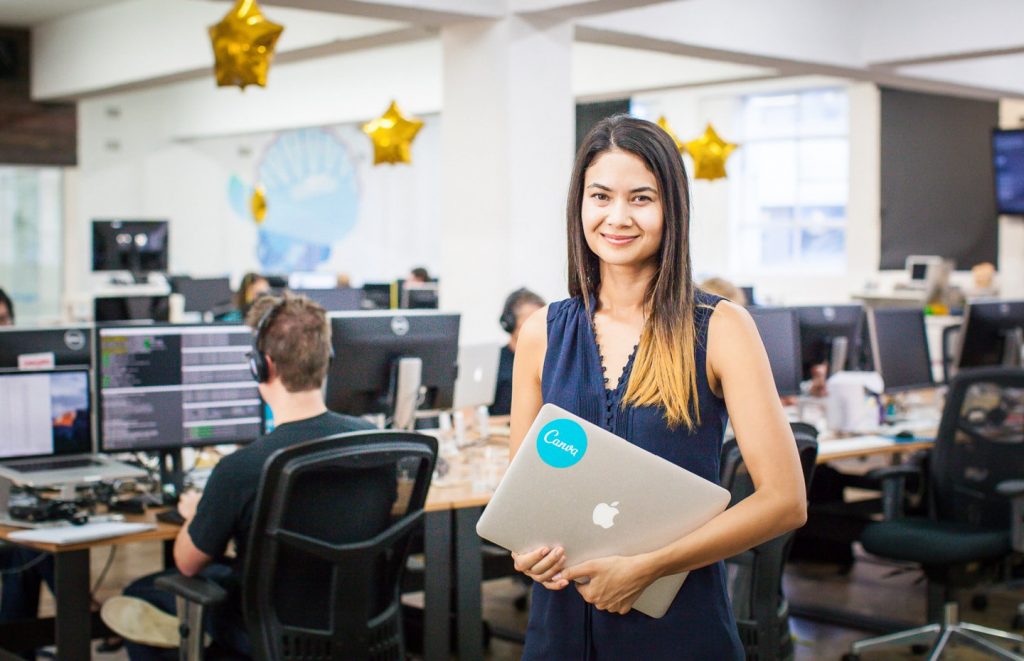30-year-old Melanie Perkins has been launching creative businesses since she was a teenager. Her first venture, designing and selling handmade scarves to sell in her hometown of Perth, Australia, was launched when she was just 14.

At the age of 22, Perkins founded her next company, an online system for schools to design their yearbooks called Fusion Books. Today, Fusion Books is the largest yearbook publisher in Australia and has a presence in France and New Zealand.
In 2013, Perkins launched her third business, Canva, a platform that allows anyone to create professional-quality designs no matter their level of expertise. Today Canva boasts more than 10 million registered users in 190 different countries. The platform is available in 100 languages and has a library of over 3 million images, with new inspiration added every day. The company, which has a team of over 250 employees, was valued at $1 billion dollars as of January 2018.
It all sounds like it came pretty easily — but it didn’t.
We caught up with Perkins to ask her 20 questions and find out what makes her tick.
1. How do you start your day?
Every morning, the first thing I do is log on to Canva’s social media channels and see what our community has been up to. I find it very motivating to hear their amazing design stories and also hear their feedback on what they’d like to see improved on our platform.
2. How do you end your day?
I’ve always found it difficult to stop whatever I’m working on and go to sleep. I’m making an extra effort this year. I have a physical calendar keeping me on track and I tick off the days when I get at least 8 hours sleep a night.
3. What’s a book that changed your mind and why?
I learned a lot from reading a book called Designing the Obvious by Robert Hoekman. It explains how to create online experiences that people will find easy, intuitive and enjoyable to use.
4. What’s a book you always recommend and why?
Designing the Obvious. It’ll change the way you think [about developing user experiences]
5. What’s a strategy to keep focused?
Good communication is one of the most important aspects of being a good leader and helping the team make good decisions on achieving their goals. At the start, there were just a few of us sitting around one table and everyone always knew what everyone else was working on. Now that we’ve grown to more than two hundred people across our two offices in Sydney and Manila, it’s important that we have a focus on making sure everyone has as much context as possible.
Throughout the week, each team catches up daily progress, and on Fridays we do a company-wide standup which is a great opportunity to bring everyone together and share knowledge. Our structure of small, empowered teams enables everyone to be nimble and move quickly and also gives each team ownership over their work so they can be as effective and creative as they can be.
6. When you were a kid what did you want to be when you grew up?
I guess you could say that design had always played a big role in my life. When I was 14 I started my first business creating handmade scarves that I sold at shops and markets throughout Perth, and I never forgot the freedom and excitement of being able to build a business. That was one of the driving forces that led me to launch what would evolve to be Canva.
7. What did you learn from the worst boss you ever had?
I can’t say I’ve ever had a terrible boss, but I did learn from fear-inducing experiences of rejection early on that it was very important for me to focus on my goal and remain persistent. Every time we got a hard question from an investor or a reason why they wouldn’t invest, we stayed focused on what we could change. I revised our pitch deck after every meeting, more than a hundred times in a year, to answer the questions or fix the reason for rejection from the last time. The normal thing to do after your 100th ‘no’ would be to stop, but you just have to persevere. I’d continuously pour my energy into things that I could refine and fix, trying to find people who believed in my vision and would come along for the ride.
8. Who has influenced you most when it comes to how you approach your work?
A key moment for me was when I first met with Lars Rasmussen, a co-founder of Google Maps. Until then, I hadn’t considered that people who start huge, world-changing companies could just be normal, lovely people. It radically changed my perspective and the scale of my vision for Canva. Lars also played a key role in helping us secure an exceptional tech team and helped us find the right tech co-founder, ex-Googler, Cameron Adams who is our CPO, as well as Dave Hearnden who is our CTO.
9. What’s a trip that changed you?
Traveling to India probably had the most impact on me. It’s like another world, the people were so welcoming and friendly and it challenged every belief that I had about life and its meaning.
11. What was your first business idea and what did you do with it?
My co-founder, Cliff Obrecht, and I decided to test the idea of making the design process much simpler by launching Fusion Books, an online design tool to help schools pull together their own designs for yearbooks.
10. What inspires you and why?
Our team have been incredibly motivated to hear stories from our community. Just recently we heard about a person who had a Canva design broadcasted on a digital billboard without any previous design training! Other than small businesses and large Fortune 500 companies, we also have over 17,000 non-profits from all around the world who are using Canva to fundraise. That’s what makes all of the work worth it.

